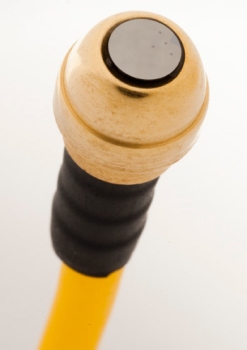Stanford researchers have designed an underwater microphone with high-sensitivity that can capture a wide range of sounds in the ocean. This underwater microphone can be used to record a soft whisper to an explosion of one ton of TNT with an intensity of nearly 160 decibels just 60 feet away. It can be used to measure sounds precisely at any depth, irrespective of the pressure.
The microphone is capable of hearing sound frequencies across a 17 octaves span, ranging between pitches much higher than a mosquito whining and lesser than a rumbling foghorn. While developing the hydrophone, the researchers considered some listening equipment that functioned well underwater specifically the ears of marine mammals for e.g. orcas.
 Onur Kilic's miniature underwater microphone
Onur Kilic's miniature underwater microphone
Onur Kilic, a postdoctoral researcher in electrical engineering and his coworkers designed a silicon chip with a thickness of 500 nm, which was nearly 25 times slimmer than ordinary plastic wrap. This silicon chip featured a grid of small nano-holes to let water pass in and out.
A microphone picks up sounds using a membrane or diaphragm placed within that vibrates as a result of the pressure waves of sound reaching it. Filling water on either side of the diaphragm hampered the amount that the diaphragm could oscillate in response to the sound waves striking it.
Kilic fitted a fiberoptic cable to the microphone that was filled with water. The cable’s end was placed adjacent to the diaphragm’s interior surface and emitted light from a laser source to the cable’s end and onto the diaphragm. Under normal circumstances, a thin diaphragm would be transparent and allow the light from the laser to escape.
But the researchers were aware that if the hole diameter that let water to enter the diaphragm had a wavelength close to that of laser light, the holes would obstruct the passage of light through the membrane. The holes would divert the light toward the cable’s tip, effectively enabling the diaphragm to act as a mirror even with allowing the passage of water.
The diaphragms are so small measuring the largest being nearly three-tenths of a millimeter in diameter. Kilic could assemble all three diaphragms into an area much smaller than the sound wavelengths that they had to sense and this allowed the effective functioning of the diaphragms. All three diaphragms can be easily accommodated into the microphone housing, which is hardly larger than the size of a pea.
The small pea-sized microphone can be useful for a wide range of research activities. It can be used to survey the ocean floor and in particle physics to use acoustic detectors to check the level of ultra-high-energy neutrinos falling into the ocean. Neutrinos are nearly zero-weight particles emitted by the sun.